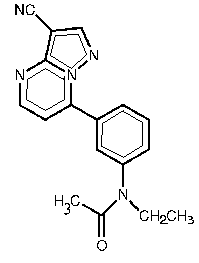Synopsis
Eszopiclone (Lunesta), a nonbenzodiazepine hypnotic agent, is indicated for the treatment of transient and chronic insomnia. Its mechanism of action is related to its activity at [gamma]-amino-butyric acid receptors. (1) Eszopiclone is an isomer of the hypnotic zopiclone (Imovane), which has been available in countries outside the United States for almost 20 years. (2)
Safety
The duration of action of eszopiclone is approximately eight hours, similar to zolpidem (Ambien) and longer than zaleplon (Sonata). The drug is metabolized in the liver by the CYP450 3A4 system, and dose adjustment is warranted in patients taking enzyme inhibitors such as ketoconazole (Nizoral). Eszopiclone is a Schedule IV con-trolled substance. No evidence of tolerance or dependence has been reported. (3,4) One case of nonfatal overdose with 36 mg of eszopiclone was reported in clinical trials. Rare cases of fatal overdose with zopiclone and concomitant central nervous system (CNS) depressants have been reported in European post-marketing studies. (1) Eszopiclone is pregnancy category C (animal studies only) and it is not approved for use in children.
Tolerability
Unpleasant taste (34 versus 3 percent), headache (17 versus 13 percent), and dizziness (7 versus 4 percent) were reported more commonly in patients taking eszopiclone than those taking placebo, respectively, in clinical trials. (1) Additive side effects are expected with concomitant use of substances with CNS-depressant activity, including alcohol. (1)
Effectiveness
There has been little published research on the effectiveness of eszopiclone in patients who have difficulty sleeping. One study (3) analyzed the use of eszopiclone for six months in 791 adult patients with chronic insomnia (age = 21 to 69 years; 63 per-cent were women). Patients reported results once weekly through an interactive voice response system and completed monthly study visits for safety and compliance assessments. After one week of therapy, eszopiclone-treated patients fell asleep a mean of 37 minutes faster, had 0.6 fewer nighttime awakenings, and slept 50 minutes longer than placebo-treated patients. Sleep quality, next-day daytime ability to function, daytime alertness, and sense of physical well-being also were improved. The effect on sleep was maintained but attenuated; at six months, eszopiclone-treated patients fell asleep approximately 16 minutes faster, had 0.7 fewer nighttime awakenings, and slept 39 minutes longer than placebo-treated patients. No studies have compared eszopiclone with non-drug insomnia therapy, zolpidem, zaleplon, or other sedative hypnotic agents.
Price
A one-month supply of eszopiclone (1-, 2-, or 3-mg tablets) will cost patients approximately $111. This price is slightly higher than the cost of comparable agents, such as zolpidem (5 mg, $81-9) or zaleplon (5 mg, $71), and is much more expensive than older benzodiazepine hypnotics.
Simplicity
The recommended starting dose of eszopiclone is 2 mg at bedtime for patients who can remain in bed for at least eight hours. (2) The dose may be increased to 3 mg at bedtime based on patient response. (1) The starting dose should be reduced to 1 mg for patients with severe liver disease, those taking potent CYP3A4 inhibitors (e.g., ketoconazole, clarithromycin [Biaxin], nelfinavir [Viracept]), and patients older than 65 years. The onset of action of eszopiclone may be delayed if taken with or immediately after a high-fat meal. (1)
Bottom Line
Similar to other hypnotic drugs, eszopiclone treats the symptom of insomnia and not the underlying cause. It offers no advantage over other nonbenzodiazepine hypnotic agents for transient insomnia and it therefore should be considered a second-line agent. As with other drugs in this class, it should not be used routinely. Although labeled for this use, long-term, continuous use of eszopiclone should be reserved for those few patients who require nightly therapy and who are able to afford the drug and tolerate the side effects.
REFERENCES
(1.) Lunesta (package insert). Marlborough, Mass.: Sepracor, Inc., 2004. Accessed online May 2, 2005, at: http://www.lunesta.com/PostedApprovedLabelingText.pdf.
(2.) Eszopiclone (Lunesta), a new hypnotic. Med Lett Drugs Ther 2005;47:17-9.
(3.) Krystal AD, Walsh JK, Laska E, Caron J, Amato DA, Wessel TC, et al. Sustained efficacy of eszopiclone over 6 months of nightly treatment: results of a randomized, double-blind, placebo-controlled study in adults with chronic insomnia. Sleep 2003;26:793-9.
(4.) Zammit GK, McNabb LJ, Caron J, Amato DA, Roth T. Efficacy and safety of eszopiclone across 6-weeks of treatment for primary insomnia. Curr Med Res Opin 2004;20:1979-91.
The Authors
ANDREA M. WESSELL, PHARM.D., B.C.P.S., C.D.E., is assistant professor, and C. WAYNE WEART, PHARM.D., B.C.P.S., is a professor in the Department of Pharmacy and Clinical Sciences, and Department of Family Medicine, Medical University of South Carolina Colleges of Pharmacy and Medicine, Charleston, South Carolina
COPYRIGHT 2005 American Academy of Family Physicians
COPYRIGHT 2005 Gale Group



